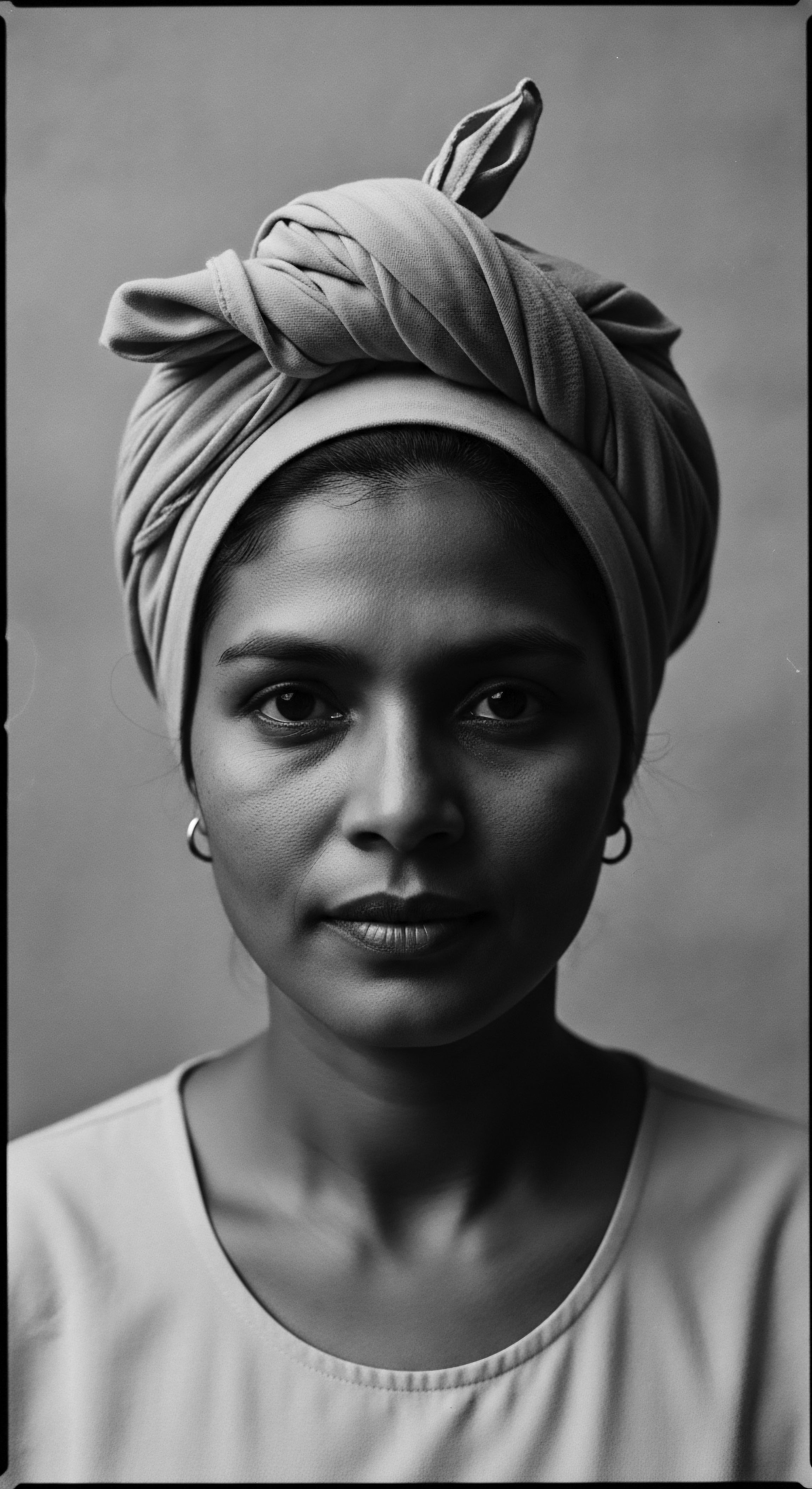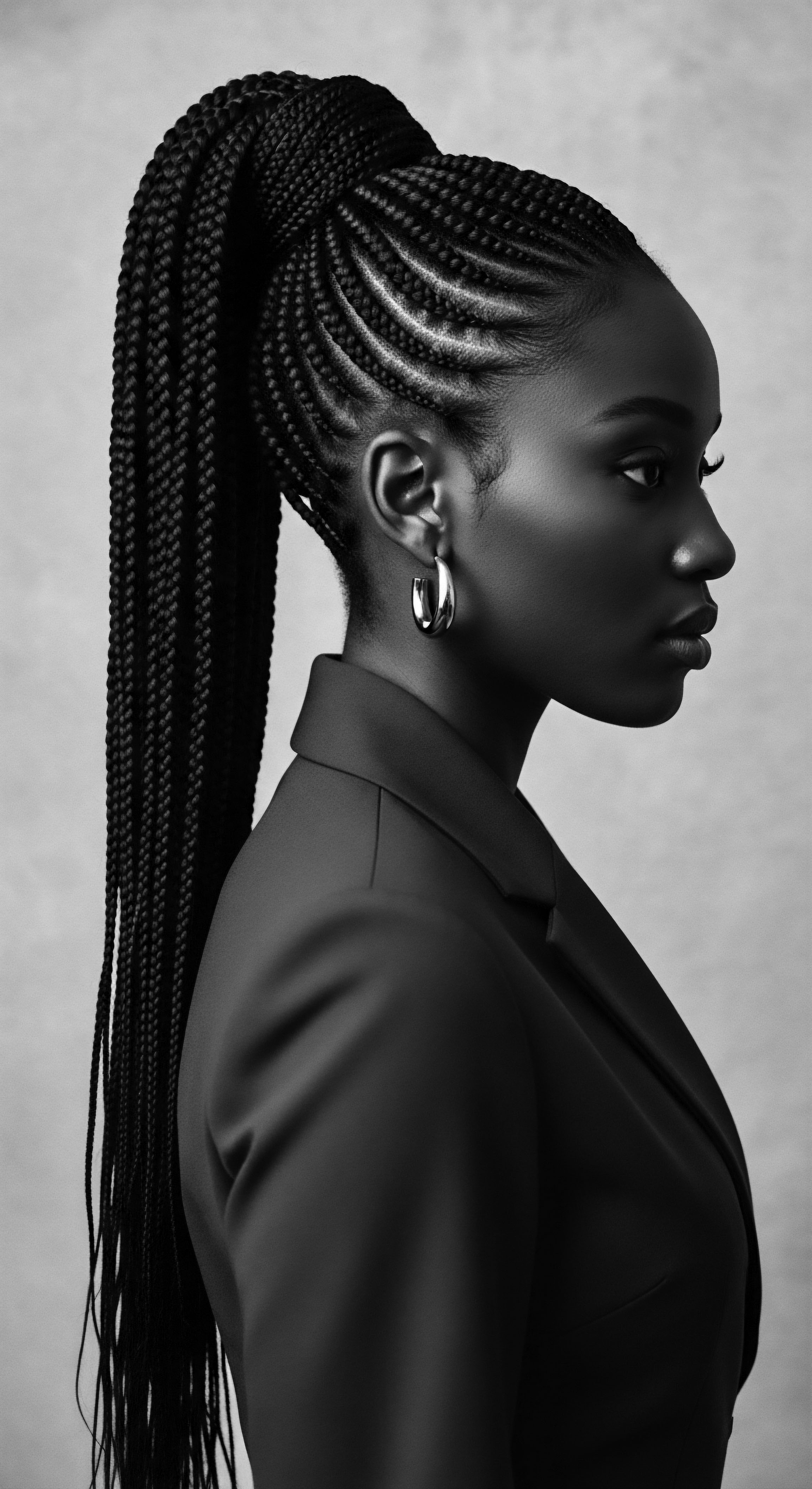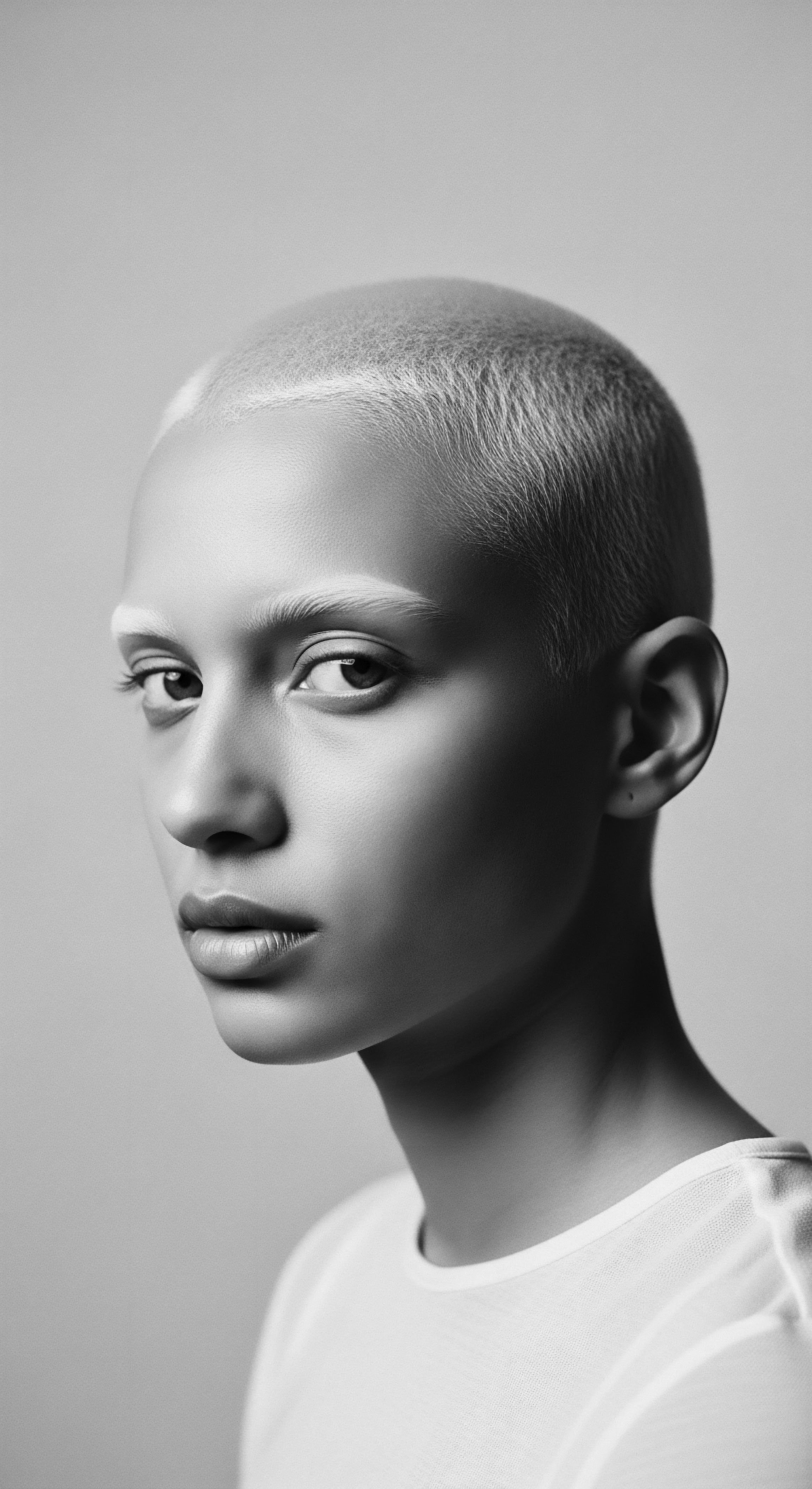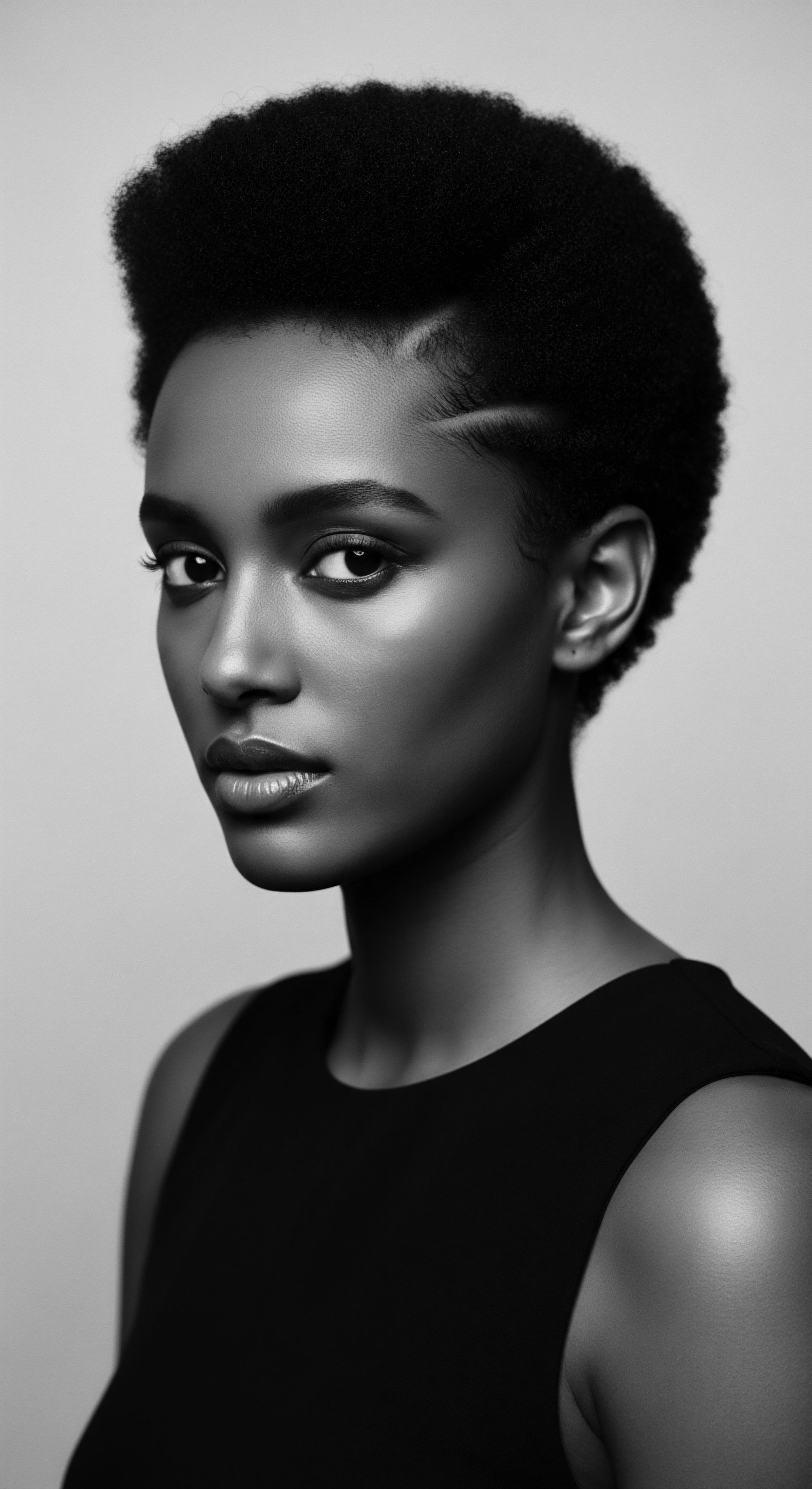
Fundamentals
The concept of African American Hair transcends a mere biological description; it stands as a profound testament to identity, an ancestral inheritance, and a living archive of resilience. Its fundamental meaning, rooted deeply in the ancient soils of the African continent, speaks to an intrinsic connection between hair, spirit, and community. Long before the brutal rupture of transatlantic servitude, hair served as a vibrant language, a visual lexicon communicating intricate details of a person’s life and standing within their collective.
In pre-colonial African societies, hair was not a peripheral adornment but a central aspect of selfhood and societal participation. Across diverse communities, the styles, patterns, and care rituals associated with hair conveyed profound messages. For instance, in many West African cultures, one could discern an individual’s marital status, age, spiritual leanings, ethnic group, wealth, or societal standing simply by observing their coiffure.
The meticulous processes involved in hair grooming, often spanning hours or even days, fostered communal bonds, becoming cherished moments of shared intimacy and the transmission of generational wisdom. These were not simply acts of beautification; they were sacred practices, deeply intertwined with spiritual beliefs, as the head was often regarded as the most elevated part of the body, a conduit for divine energy and ancestral connection.
The very definition of African American Hair, therefore, begins with this deep-seated heritage. It is an acknowledgment of hair that naturally coils, kinks, and curls, possessing a unique structural integrity that sets it apart. This hair, often described as having a tightly coiled or spring-like formation, emerges from elliptical follicles that curve gently beneath the scalp, giving each strand its characteristic helical shape. This inherent morphology, a gift of genetic inheritance, contributes to its magnificent volume and unique texture, qualities revered in traditional African aesthetic sensibilities.
The earliest ancestral practices surrounding African American Hair focused on stewardship and adornment, recognizing hair as a vital extension of one’s being. Traditional ingredients, sourced from the bountiful earth, formed the bedrock of hair care. Substances like shea butter, derived from the karite tree, and nutrient-rich palm oil were not only emollients but also revered components in rituals designed to nourish and protect the hair and scalp. These practices were steeped in an understanding of the hair’s needs, providing natural lubrication and strengthening its fibers, ensuring its vitality amidst varied climates and demanding lifestyles.
African American Hair, at its core, represents a continuum of identity, care, and cultural expression, originating from ancient African traditions and adapting through centuries.
The communal nature of hair care, a practice where elders would tend to the hair of younger generations, or where women gathered to braid and style, solidified familial and community ties. These gatherings were more than just styling sessions; they were oral histories unfolding, moments where stories were shared, wisdom imparted, and cultural norms reinforced. The very act of tending to another’s hair became a tender thread, weaving individuals into the larger fabric of their collective heritage. This fundamental understanding of hair as a communal and spiritual asset, rather than merely a physical attribute, forms the genesis of its enduring significance for people of African descent.

Ancient Echoes in Hair’s Biology
The unique structural composition of African American Hair, characterized by its distinctive curl patterns, holds echoes of its ancient lineage. Unlike hair with a more circular cross-section that grows straight, African hair typically possesses an elliptical or flattened cross-section, leading to its signature coiling. This structural aspect, while conferring magnificent volume and natural artistry, also means that the hair’s natural oils, known as sebum, do not travel down the hair shaft as readily as on straighter textures. This inherent biological characteristic meant that ancestral communities developed care regimens specifically designed to address moisture retention and prevent dryness, relying on a wealth of botanical resources.
- Coiled Morphology ❉ The tight, spring-like coils of African American hair stem from its elliptical follicle shape, a feature distinguishing it from other hair types.
- Sebum Distribution ❉ Natural oils produced by the scalp face challenges traversing the helical path of coiled strands, necessitating deliberate moisture replenishment.
- Fiber Brittleness ❉ The points where hair strands bend in their coiled pattern can be areas of fragility, a characteristic that ancestral care methods sought to fortify with rich emollients.

Early Cultural Delineations Through Hair
Across the vast tapestry of pre-colonial Africa, hair served as a powerful non-verbal communication system. Specific styles could signal a woman’s readiness for marriage, a warrior’s preparation for battle, or a community’s mourning period. For example, in the Wolof tribe of modern-day Senegal and The Gambia, young women might shave a portion of their hair to signify their availability for marriage, while men preparing for war adopted distinct braided styles. These visual cues were universally understood within their cultural contexts, underscoring hair’s role as a social identifier.
The symbolic import extended to spiritual realms. The Yoruba people, for instance, considered hair the most elevated part of the body, a channel for communication with deities and ancestors. Braided patterns were not simply decorative; they were believed to convey messages to the divine, reflecting a deep spiritual connection inherent in the act of hair grooming. This spiritual dimension imbued hair care with a reverence that transcended mere aesthetics, elevating it to a ritualistic practice.
The tools and adornments used in these early practices were also deeply meaningful. Combs crafted from wood or bone, and decorative elements like beads, cowrie shells, and natural fibers, were not just functional items. They were often imbued with cultural significance, representing prosperity, protection, or tribal affiliation. The very process of hair styling, requiring patience and skill, transformed into an act of communal art, preserving cultural identity and fostering bonds that would prove invaluable through generations.

Intermediate
The intermediate meaning of African American Hair delves deeper into how its heritage practices, shaped by historical forces, have been transmitted and transformed across generations. This phase of understanding acknowledges the profound resilience woven into each strand, as hair care rituals became acts of cultural preservation and quiet resistance in the face of immense adversity. The transatlantic slave trade marked a cataclysmic rupture, yet even amidst forced displacement and dehumanization, the deep-rooted significance of hair persisted, adapting to new, brutal realities.
Upon arrival in the Americas, enslaved Africans were often subjected to the cruel indignity of having their heads forcibly shaved, a deliberate act intended to strip them of their identity and cultural connections. This violent severance from ancestral hair practices was a calculated attempt to erase their personhood. Despite these efforts, African people maintained a profound connection to their hair, which became a silent yet potent expression of their identities in a foreign land. The ingenuity and determination of enslaved individuals led to the adaptation of traditional hair care methods using whatever scarce resources were available, such as animal fats, butter, or goose grease, to maintain scalp health and hair manageability.
This period saw the clandestine continuation of hair grooming as a means of cultural continuity and community bonding. Communal gatherings, often on Sundays, served as precious opportunities for enslaved people to braid each other’s hair, sharing not only styling techniques but also stories, solace, and strategies for survival. The act of hair styling became a subversive affirmation of self, a quiet rebellion against oppressive systems designed to strip away their humanity.
Hair became a covert canvas during enslavement, bearing hidden messages and preserving ancestral wisdom through intricate patterns.
A powerful instance of this resilience and ingenuity is the documented use of cornrows as a means of covert communication and resistance. In regions like Colombia, enslaved individuals reportedly braided intricate patterns into their hair that served as maps, indicating escape routes or safe houses along paths to freedom. Some even concealed rice seeds within their braids, a desperate yet hopeful act to carry sustenance and the potential for new life from their homelands into an uncertain future. This historical example powerfully illuminates the African American Hair’s profound connection to textured hair heritage and ancestral practices, transforming a personal adornment into a tool of liberation.
(Byrd & Tharps, 2001). This historical fact, often overlooked, speaks volumes about the depth of ingenuity and the enduring spirit of a people determined to retain their heritage against unimaginable odds.

Adaptation and Resilience in Hair Care
The challenges of enslavement necessitated practical adaptations in hair care. Styles like cornrows, while deeply symbolic, also offered a practical solution for managing hair under harsh conditions, protecting it from damage and keeping it neat for extended periods. Headwraps, too, became prevalent, serving not only as protection from the elements but also as a way to maintain modesty and dignity, evolving into statements of personal style and cultural affiliation. This period saw the blending of African techniques with new influences, forging new expressions of textured hair care that carried the legacy of the past forward.
The continuity of these practices, even in fragmented forms, laid the groundwork for future generations. The knowledge of how to care for tightly coiled hair, the understanding of its need for moisture, and the communal aspect of grooming, were passed down through whispers and hands-on lessons within families. This intergenerational transmission of knowledge ensured that the “Soul of a Strand” remained vibrant, despite systematic attempts to diminish it.
The rise of Black hair care entrepreneurs in the late 19th and early 20th centuries, such as Annie Turnbo Malone and Madam C.J. Walker, represents another crucial phase in the intermediate understanding of African American Hair. These visionary women recognized the unmet needs of Black women and developed specialized products and systems that not only addressed hair and scalp health but also provided economic empowerment and a sense of pride. Their innovations, often drawing from traditional knowledge of natural ingredients, transformed the landscape of hair care, moving it from a clandestine act of survival to a burgeoning industry of self-affirmation.
| Era Pre-Colonial Africa |
| Traditional Practice / Adaptation Intricate braiding, oiling with shea butter, communal grooming. |
| Significance to Heritage Communication of status, spiritual connection, community bonding. |
| Era Transatlantic Slave Trade |
| Traditional Practice / Adaptation Cornrows as maps, hiding seeds, using animal fats for moisture, headwraps. |
| Significance to Heritage Resistance, survival, preservation of identity, covert communication. |
| Era Post-Emancipation / Early 20th Century |
| Traditional Practice / Adaptation Development of specialized Black hair products (e.g. Madam C.J. Walker's formulations), establishment of beauty schools. |
| Significance to Heritage Economic empowerment, addressing specific hair needs, building community infrastructure. |
| Era These practices demonstrate the enduring spirit of innovation and cultural preservation within African American hair traditions. |

The Evolution of Style as a Statement
As the narrative of African American Hair progressed, styles continued to carry layered meanings. From the early 20th century’s emphasis on straightened hair, often seen as a means of assimilation or professional acceptance in a discriminatory society, to the powerful re-emergence of natural textures during the Civil Rights Movement, hair became a potent symbol of sociopolitical shifts. The Afro, in particular, became a declaration of Black pride and a rejection of Eurocentric beauty norms, signifying a profound embrace of African roots and a stand against oppression. This movement, though not the first instance of natural hair being celebrated, marked a significant public reclamation of indigenous beauty standards.
The journey of African American Hair through these periods reveals a continuous interplay between external pressures and internal fortitude. It underscores that hair is never simply hair; it is a profound expression of a people’s history, their struggles, and their triumphs. The methods of care, the chosen styles, and the communal rituals all reflect a deep-seated reverence for an inherited legacy, ensuring that the essence of textured hair heritage remains vibrant and relevant through the ages.

Academic
The academic definition of African American Hair offers a sophisticated, multi-disciplinary explication, positioning it not merely as a biological phenotype but as a complex socio-cultural construct, a historical document, and a dynamic expression of identity within the African diaspora. This advanced understanding integrates biological realities with anthropological insights, historical trajectories, and contemporary sociological discourse, revealing the intricate interplay of factors that have shaped its meaning and significance. It necessitates a deep dive into the nuanced understanding of its physical characteristics, the historical forces that have impacted its perception, and its ongoing role in self-determination and cultural affirmation.
From a biological standpoint, African American Hair is characterized by its distinctive morphology, a subject of ongoing scientific inquiry. The hair follicle, typically elliptical or ribbon-like in cross-section, produces strands that exhibit a unique helical coiling pattern. This coiling, often described as having multiple twists and turns along its length, results in hair that grows parallel to the scalp before curving outward.
While African hair produces a comparable or even greater amount of sebum compared to other hair types, the tightly coiled structure impedes the even distribution of this natural lubricant along the hair shaft, rendering the hair more prone to dryness and, consequently, to mechanical fragility at its points of curvature. This inherent biological reality underscores the historical necessity of protective styling and diligent moisture replenishment, practices deeply embedded in ancestral care traditions.
Anthropologically, African American Hair serves as a potent marker of cultural identity and continuity. Pre-colonial African societies utilized hair as a sophisticated semiotic system, conveying a vast array of social data—from age and marital status to spiritual devotion and tribal affiliation. The systematic shaving of heads during the transatlantic slave trade was a calculated act of symbolic violence, designed to dismantle these established social structures and strip individuals of their cultural memory.
Yet, even in the face of such profound dehumanization, hair persisted as a site of covert resistance and cultural preservation. Enslaved people ingeniously adapted their grooming practices, using readily available materials and transforming hair styling into a communal ritual that fortified bonds and transmitted a living heritage.
African American Hair embodies a profound cultural language, adapting through historical shifts while retaining its core ancestral meaning.
Historically, the trajectory of African American Hair reflects a continuous negotiation with dominant beauty standards. The post-emancipation era saw a push towards hair straightening, often influenced by the pervasive Eurocentric aesthetic that equated straight hair with respectability and social mobility. This period gave rise to pioneering Black entrepreneurs like Madam C.J.
Walker and Annie Turnbo Malone, who, while often developing products for straightening, simultaneously built economic empires that empowered Black women and created pathways for self-sufficiency within a segregated society. Their contributions, though complex in their historical context, laid the foundation for an independent Black beauty industry that recognized and catered to the specific needs of textured hair.
The mid-20th century witnessed a powerful reclamation of natural hair during the Civil Rights and Black Power movements. The Afro, in particular, emerged as a visible emblem of racial pride, political defiance, and a conscious rejection of imposed beauty norms. This movement underscored hair’s capacity as a political statement, a symbol of collective identity, and a means of affirming Black personhood.
This historical shift is now reinforced by contemporary movements, such as the CROWN Act, which seeks to legally protect individuals from hair discrimination based on texture and protective styles, acknowledging hair as an intrinsic part of racial identity and cultural heritage. The ongoing need for such legislation highlights the persistent societal biases against natural Black hair, even in modern contexts.

Psychosocial and Economic Dimensions of Hair
The psychosocial impact of African American Hair is extensive, deeply influencing self-perception, community belonging, and mental well-being. Hair is inextricably linked to identity for Black women and girls, with historical and ongoing experiences of discrimination contributing to psychological distress for some. Conversely, embracing natural hair can be a powerful act of self-acceptance and a source of empowerment, fostering a strong sense of cultural authenticity and connection to ancestral roots. The communal rituals of hair care, whether in family homes or professional salons, continue to serve as vital spaces for intergenerational exchange, emotional support, and the reinforcement of shared heritage.
Economically, the Black hair care industry has always been a significant, often undervalued, sector. From early independent entrepreneurs to today’s multi-billion-dollar market, it represents a powerful instance of economic self-determination within the Black community. This industry, born from necessity and a deep understanding of unique hair needs, has consistently innovated, developing specialized products and techniques for textured hair. It stands as a testament to the entrepreneurial spirit and the economic power of Black consumers, driving both cultural and commercial shifts.
The meaning of African American Hair is thus a compound phenomenon ❉ it is a biological reality with unique structural properties, a historical narrative of survival and adaptation, an anthropological artifact signifying social and spiritual connections, a political statement of identity and resistance, and a psychosocial anchor for self-esteem and community solidarity. Its ongoing evolution reflects a dynamic heritage, constantly being reinterpreted and celebrated by individuals and communities who find profound significance in every coil, kink, and curl. Understanding this hair demands a comprehensive, empathetic lens that honors its deep past while recognizing its vibrant present and boundless future.

Intersections of Biology and Heritage in Care
The scientific understanding of African American Hair informs culturally attuned care practices. Knowing that the hair’s coiled structure limits sebum distribution reinforces the ancestral wisdom of frequent moisturizing and sealing. Traditional ingredients like shea butter and coconut oil, long used for their emollient properties, find validation in modern scientific discourse for their ability to penetrate and nourish the hair shaft, thereby reducing dryness and breakage. This synergy between inherited knowledge and contemporary science allows for optimal care strategies that respect the hair’s natural inclinations while maximizing its health and vitality.
For instance, the practice of protective styling, such as braiding, twisting, and locing, which has ancient roots in African communities, is scientifically recognized for minimizing manipulation, reducing exposure to environmental stressors, and retaining length by preventing breakage. This confluence of heritage and science offers a holistic approach to hair care, acknowledging that the most effective methods often draw from a deep well of ancestral observation and ingenuity.
- Structural Understanding ❉ The elliptical cross-section of the hair follicle produces a tightly coiled strand, which impacts moisture distribution and susceptibility to mechanical stress.
- Moisture Preservation ❉ Due to the unique structure, African American hair requires consistent hydration and emollients to prevent dryness and enhance elasticity.
- Protective Styling ❉ Styles like braids and twists, inherited from ancestral practices, minimize manipulation and safeguard the hair from environmental damage.
- Ethnobotanical Wisdom ❉ Traditional African ingredients, such as shea butter and various oils, provide deep nourishment and protection, aligning with the hair’s biological needs.
The ongoing academic exploration of African American Hair extends to its representation in media and its role in broader societal dialogues. Research continues to unpack how Eurocentric beauty standards have historically marginalized textured hair and how the natural hair movement is actively dismantling these biases, fostering a more inclusive and expansive vision of beauty. This scholarly pursuit not only documents the historical journey of African American Hair but also provides critical frameworks for understanding its contemporary relevance and its potential to shape future perceptions of beauty and identity globally.

Reflection on the Heritage of African American Hair
To contemplate African American Hair is to engage in a profound meditation on heritage itself. Each curl, each coil, each intricate pattern holds within it the echoes of ancient rhythms, the whispers of resilience, and the vibrant stories of a people who have navigated centuries with grace and unwavering spirit. It is a living, breathing testament to the ingenuity of ancestral hands that first sculpted hair into statements of identity, status, and spiritual connection. This legacy, passed down through generations, survived the unspeakable cruelties of forced migration and the persistent pressures of assimilation, transforming acts of survival into powerful declarations of selfhood.
The journey of African American Hair is not a linear progression but a cyclical dance between tradition and transformation, a continuous affirmation of the “Soul of a Strand” ethos. It reminds us that beauty is not monolithic; it is a spectrum of magnificent expressions, each rooted in a unique history and cultural context. The practices of care, the styles chosen, and the communal rituals surrounding hair are not merely aesthetic choices; they are acts of honoring lineage, acts of self-love, and acts of profound cultural preservation.
This hair, in all its diverse manifestations, embodies a strength that goes beyond its physical structure. It is a symbol of a people’s enduring capacity to find beauty, meaning, and connection amidst adversity. It speaks to the power of reclaiming one’s narrative, celebrating what is inherently theirs, and shaping a future where every texture is revered, every heritage acknowledged, and every strand allowed to flourish in its natural splendor. The heritage of African American Hair is a beacon, illuminating the path towards a more inclusive and deeply appreciative understanding of beauty in our shared human story.

References
- Byrd, A. D. & Tharps, L. L. (2001). Hair Story ❉ Untangling the Roots of Black Hair in America. St. Martin’s Press.
- Jacobs-Huey, L. (2006). From the Kitchen to the Parlor ❉ Language and Becoming in African American Women’s Hair Care. Oxford University Press.
- Patton, T. O. (2006). Hey Girl, Am I More than My Hair? ❉ African American Women and Their Struggles with Beauty, Body Image, and Hair. NWSA Journal, 18(2), 24-51.
- Rooks, N. (1996). Hair Raising ❉ Beauty, Culture, and African American Women. Rutgers University Press.
- Johnson, T. & Bankhead, T. (2014). Hair It Is ❉ Examining the Experiences of Black Women with Natural Hair. Open Journal of Social Sciences, 2, 86-100.
- Lashley, M. (2020). The importance of hair in the identity of Black people. Journal of Black Psychology, 46(1), 3-21.
- Bundles, A. (2001). On Her Own Ground ❉ The Life and Times of Madam C. J. Walker. Scribner.
- Wolfram, L. (2003). Human Hair ❉ A Unique Physicochemical Composite. Journal of the American Academy of Dermatology, 48(6), 106-114.
- Tate, S. (2007). Black beauty ❉ Shade, hair and anti-racist aesthetics. Ethnic and Racial Studies, 30(2), 300-319.
- Mercer, K. (1994). Welcome to the Jungle ❉ New Positions in Black Cultural Studies. Routledge.
- Sharaibi, O. J. Oluwa, O. K. Omolokun, K. T. Ogbe, A. A. & Adebayo, O. A. (2024). Cosmetic Ethnobotany Used by Tribal Women in Epe Communities of Lagos State, Nigeria. Journal of Complementary Medicine & Alternative Healthcare, 12(4), 555845.
- Mboumba, R. M. & Kambu, O. J. (2024). Cosmetopoeia of African Plants in Hair Treatment and Care ❉ Topical Nutrition and the Antidiabetic Connection? Diversity, 16(2), 96.
- Dabiri, E. (2019). Twisted ❉ The Tangled History of Black Hair Culture. Penguin Books.
